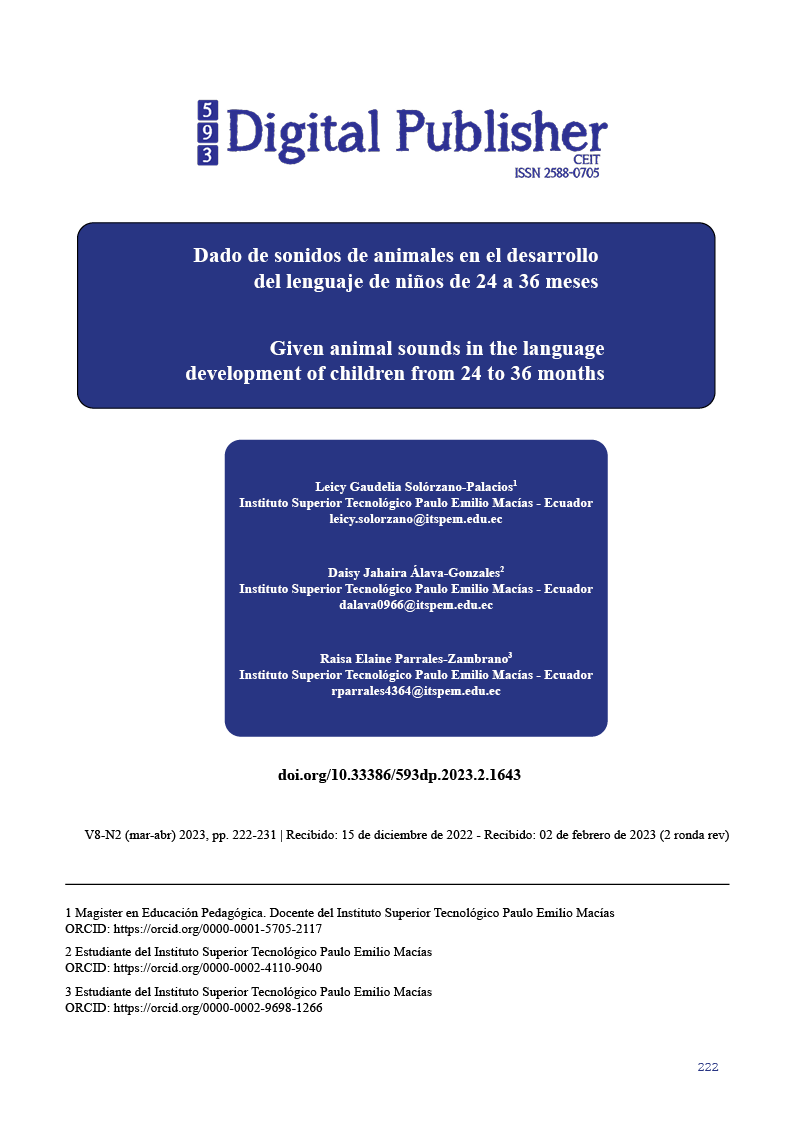Given animal sounds in the language development of children from 24 to 36 months
Main Article Content
Abstract
Through this study we wanted to present a series of characteristics of children's language in the period between twenty-four and thirty-six months of age, which have emerged from an investigation carried out with children from the Child Development Center " Happy smiles”. The most important deduction provided by the work carried out has been to highlight above all the importance of the environment and communication in the development of language in children during this stage of their lives, since it is a time of experimentation and of internalization at the cognitive level of those linguistic structures that are shown around it. Although it is true that traditional strategies have given good results in early childhood education, it is important that there is a variation of these techniques in language teaching, that take advantage of the innate learning of children such as imitation; for which an innovative support material is proposed that stimulates the child to improve their oral expression by imitating the different sounds of animals that they hear daily. Oral language is a regulated system, very complex. It allows an exchange of information through a certain coding system. It is not the only one, but thought is structured, invented and recreated with it; regulates interpersonal relationships, the subject's own behavior and permeabilizes the child in the sociocultural environment in which he is immersed. Its development is the result of the interaction between the biological bases and the physical and social environment that surrounds the child.
Downloads
Article Details

This work is licensed under a Creative Commons Attribution-NonCommercial-ShareAlike 4.0 International License.
1. Derechos de autor
Las obras que se publican en 593 Digital Publisher CEIT están sujetas a los siguientes términos:
1.1. 593 Digital Publisher CEIT, conserva los derechos patrimoniales (copyright) de las obras publicadas, favorece y permite la reutilización de las mismas bajo la licencia Licencia Creative Commons 4.0 de Reconocimiento-NoComercial-CompartirIgual 4.0, por lo cual se pueden copiar, usar, difundir, transmitir y exponer públicamente, siempre que:
1.1.a. Se cite la autoría y fuente original de su publicación (revista, editorial, URL).
1.1.b. No se usen para fines comerciales u onerosos.
1.1.c. Se mencione la existencia y especificaciones de esta licencia de uso.
References
Alessandri, M. (2007). Trastornos del Lenguaje. Buenos Aires-Argentina: Landeira ediciones S.A.
Astorga, N. C. (13 de agosto de 2018). La importancia de la socialización en la infancia. Obtenido de Azul Maya Club Infantil: https://clubinfantilazulmaya.wordpress.com/2014/08/13/la-importancia-de-la-socializacion-en-la-infancia/
Castañeda, P. (1999). El lenguaje verbal del niño, España: Fondo editorial.
Fuentes, A. S. (2018). Educapeques.com. Obtenido de https://www.educapeques.com/.
Gili Gaya, S. (1961). Imitación y Creación en el habla infantil. Obtenido de: https://www.rae.es/sites/default/files/Discurso_de_ingreso_Samuel_Gili_Gaya.pdf.
Haiman, P. E. (2019). la influencia de los padres en lenguaje de sus hijos.
Jiménez, A. (30 de enero de 2017). Bezzia.com. Obtenido de https://www.bezzia.com/ambitos-del-juego-en-el-desarrollo-infantil
Mafla León, C. (2012). La imitación de sonidos y el desarrollo del lenguaje oral en los niños de 2 a 3 años que asisten al Centro de Desarrollo Infantil Bilingüe “Nueva Semilla” de la parroquia Atahualpa en el período abril – septiembre del 2011. Obtenido de: http://repositorio.uta.edu.ec/bitstream/123456789/7158/1/LA%20IMITACI%c3%93N%20DE%20SONIDOS%20Y%20EL%20DESARROLLO%20DEL%20LENGUAJE%20ORAL.pdf.
Ministerio de Educación. (2015). Rutas de Aprendizaje versión. Obtenido de ¿Qué y cómo aprenden nuestros niños y niñas?:.
Ordoñez, M y Tinajero, A (2005). Estimulación Temprana Inteligencia emocional y cognitiva, Barcelona, España
Owens, Robert (2004). Desarrollo del lenguaje. Madrid: Pearson Education, S.A., 2003, p.57. Obtenido de: https://revistas.unal.edu.co/index.php/formayfuncion/article/view/17292
Rosengard. (29 de septiembre de 2020). Imágenes Educativas. Obtenido de https://www.imageneseducativas.com/5-formas-de-estimular-es-lenguaje-expresivo/#:~:text=Rosengard%20asegura%20que%20el%20lenguaje,acumulaci%C3%B3n%20de%20recuerdos%20e%20informaci%C3%B3n.%C2%BB.
Tamami Tualombo, M. (2017). La Estimulación temprana en el desarrollo del lenguaje oral en niño y niñas de 3 a 4 años en la Unidad Educativa Aida Gallegos de Moncayo. Obtenido de: http://www.dspace.uce.edu.ec/bitstream/25000/12554/1/T-UCE-0010-007-2017.pdf.
Vernon, S y Alvarado, M (2014). Aprender a Escuchar, Aprender a Hablar. La Lengua Oral en los Primeros años de Escolaridad. México: INNE.
Vygotsky, L. (1982). Obras escogidas. Moscú: Editorial pedagógica.




